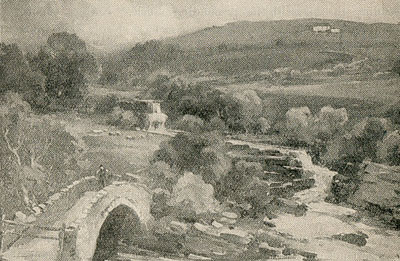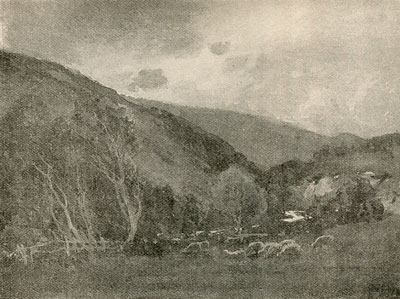Between Muker and Swinnergill it flows broadly shallowed
over a rock-strewn course, with many a narrow boiling cauldron
or grey mare's tail like channel on one side or the other,
so many natural goits or strids. The banks being low, the
swath land is often inundated to the very foot of the wall
of Kisdon. Every yard seems to take one further into some
wild virgin land, fit haunt for hill fox, grey wolf or brown
bear - so lonesome and awe-inspiring is Nature in her sterner
phase here. A strange stillness
WILD BORDERLAND OF RICHMONDSHIRE
page 108
reigns, broken now and again, as the condition
of the atmosphere carries or obstructs, by the voice of
Swale, the plash of water somewhere falls on the ear, or
hark! that is the pitiful bleat of some strayed lamb. Far
away through the thin air to-day, from the heights of Kisdon
comes the call of a shepherd to his collie, and its yelp,
yelp in answer. It is witchingly 'fey' this gorge, this
mountain-land's throat of stone that gives out such eerie
sounds. We are now toiling up the most magnificent scenery
of the dale, Swale foaming and leaping downwards through
a deep cavernous hollow in the hills. Gaunt and forbidding
is the aspect of everything save the live flashing water;
a subtle sense of ghostiness and seclusion pervades this
place, the lone home of corbie-crow, raven, falcon and buzzard.
Down deeply gashed and cloven gills, waters surge in tangled
ropes of foam. Nearing Keld the banks grow more irregular
and broken by scars, the path winding up through a portion
of the old Keld forest. In the sombre light of twilight
we see, through gnarled and lichen-crusted stems of trees
garbing the scars, the Swale - old yet ever new, the same
to-day as yesterday and for ever - like some snorting war-horse
with tawny mane, lashing itself into furied foam on the
fang-like jaws of limestone scar as it leaps in mad career
through this forest gnome land. Brushwooded fells rise steeply
above the lower scar stairways, glowing to the very sky-line
that backgrounds them, a sea of colour, greens, greys and
russets. It is impossible to depict in words the wondrous
loveliness, the dignity and stern grandeur of this length
of Swale. The impression of its beauty is stamped for all
time on our mind.
To reach Swinnergill from Muker we must cross
the Swale by the footbridge some half mile above the village,
and then proceed along the east bank under the grand bastion
of Melbecks Moor, until we arrive at the mouth of the beck,
and then follow up stream for a few hundred yards. It is
a rough road owing to the numer-
WILD BORDERLAND OF
RICHMONDSHIRE page 109
ous boulders strewn in its channel. There are several
cascades, and at the foot of one a cavern (caused maybe
by volcanic action), the roofs and sides of which have
the appearance of petrified or

Swinnergill Kirk [R. Rodwell |
lapidary polished mud, deeply scored with
indentations made by the trickle of water during countless
centuries. The entrance is low, but after a dozen yards
or so the rift gets more spacious, and a man can stand upright.
Its length is about 50 to 60 yards. The best way to reach
the cave is by way of Keld and Crackpot
WILD BORDERLAND OF RICHMONDSHIRE
page 110
Hall, and it is locally known by the name
of "Swinnergill Kirk." It was used as a secret
place of worship during times of persecutions for Faiths.
It is most likely that ordinarily meetings for service would
be held in the gill near the cave's mouth, for a single
lookout posted on the hill slope above would be able to
see every enemy and give warning of their approach, when
the cave would doubtless be used as a hiding place until
danger passed. It has also done service as a Refuge during
the aggressive warfare of Celt, Saxon and Norman. The waters
of Swinnergill rise on the south side of Rogan's Seat, and
the stream has pretty features but the passage is too rough
for it to be often followed beyond the cave. From here we
make over Hall-out-pasture - a spur of Rogan's Seat overlooking
Crackpot hall - which commands fine views of Kisdon and
up the river to near its source, and the rich olive pasture
upland through which it meanders. Cracket (cracked) Pot
Hall (a pot or depression which water has worn in the lime-rock)
is a lone 'Gaard' (Norse term yet for a farmstead) sited
on a high shelf of the hills, the house, like an eagle's
eyrie, is magnificently situated, the view on the approach
to it of truly Alpine character. A hall, one time the home
of the Knowles' family, it is now a farmstead in the occupation
of Kit Calvert. In its place formerly stood the house of
the deer-keeper for the great lords of Swaledale in its
upper part. On our visit the sight of the primitive kail
pot spoke forcibly of bygone days, when it was put bodily
upon the stout oaken table, and everyone stood up and served
himself to the savoury mess, filling his trencher by the
aid of a huge leaden or wooden spoon!
We are now in the Land of Fosses, and the
scene from the north side is both striking and magnificent.
We glimpse the river far below over a forest-like array
of trees and abrupt jagged masses of rock, swathed literally
in olive and bice-hued mosses, and spangled with the silver
star flowers of the leadworts (Arenaria
WILD BORDERLAND OF
RICHMONDSHIRE page 111
verna in spring, and A. nodosa
in later summer) and the pert lilac candelabra-like tube
flowers of the felwort (Gentiana Amarella) in autumn.
Nature has indeed been lavish in displaying her charms here;
between this sea of colour and white limestone walls the
river plunges in seething arrowy flight like a steel sword
cutting in two the dale were not its voice suggestive rather
of a living force filling the air with its resounding music.
Spring, summer, autumn, it is always beautiful, perhaps
most sternly so in winter, when huge blocks of ice, like
a broken up glacier, hang pendent from the rocks on its
banks and nearly close in the water in a transparent tunnel,
or cave of Aladdin for sparkling points of light.
Kisdon (from Kis, Celtic, little, and
dun, a detached hill) is so named only in comparison
with the vastly bigger bulks of Rogan, Shunor or Nine Standards
Rigg. It is of oval configuration with steeply sloping sides,
not broken by gill gullies because of the limited area of
its gently rounded almost plateau-like summit. It is the
Table Mountain of Swaledale.
A little further west we reach East Stones
Gill, draining the moorlands above from the western slopes
of Rogan's Seat, and its beck falls into the Swale above
Kisdon foss. In its upper reaches it has worn itself a deep
bed into the moor, and is bare and treeless near its junction
with the river; it is beautifully wooded, with the arboreal
flora of limestone soils, Rowan-tree scarlet cluster-berried
in autumn, nut-trees, hawthorns of great age and weird aspect,
ash, oak and juniper. The gill beck jumps down towards its
bourne, the river, in a string of lovely cascades. Beldy
hill is also on the north bank, 'howe' shaped; it was formerly
a lead-mining station. Here, crossing a bridge, we follow
the picturesque path to Keld, the very name betokening water.
Keld is the highest village in the dale. Builded out of
the hills it naturally takes on
WILD BORDERLAND OF
RICHMONDSHIRE page 112
the same aspect. Standing high up on the south
bank of the here youthful Swale, little to shield it from
the fury of the elements, it appears as gaunt, bleak and
bleached as the moorland scars which encompass it. No other
place, not Aysgarth even, can equal it for river and hill
scenery, sternly grand, sublimely beautiful, and even

The Swale and East Stonedale Beck
[Owen Bowen
|
to the folk-lore lover's eye, romantic; there
is the gloom of mountain form, the picturesque commingling
of overhanging wood and precipices. The river at times shrunken
deep down in its bed of rock is shadowily seen, mysteriously
audible as of a voice from the underworld; the colour of
every living and dead thing is so variable - here the misty
tender scenic outlinings of a Claude, there the magnificent
lowering storm effects of a Turner. Strangely beautiful
is this spot when the hills are bathed in sunshine, transfigured!
and dark cloud shadows, like ships, pass airily skimming
WILD BORDERLAND OF
RICHMONDSHIRE page 113

The Swale Valley, near Keld [Owen
Bowen
|
WILD BORDERLAND OF
RICHMONDSHIRE page 114
over the hills and out of sight; and to the
ear there comes at intervals the distant tinkle, tinkle
of a tiny waterfall, the soothing gentle plash of running
water. Nor is music lacking at Ked even when the songbirds
of summer have long winged their way to milder shades; and
Neddy Dick has laid aside his tinkling bells and singular
sounding "stones," the music of untiring Nature
never ceases to vibrate on the wings of the air, from the
strings of "Eolus harp." The wind wails an intermitting
requiem for summer fled through the Scots' firs overhanging
the precipice; and Swale adds its thunderous organ-like
notes. One can be lulled to sleep by its croon in fine days,
and awed in spirit by its dirge in foul weather. Many a
waterfall adds an instrument to the production of the symphony,
to rouse us at times to the accrescent roar and velocity
of the water sprite's fury during some storm that sounds
as though it were the war din of worlds.
Of the ancient history of Keld little is on
record. Its name is evidence of its antiquity as a settlement,
and round it are signs and vestiges shewing its early occupation,
the place giving its name to a family of some estate. In
1307 there is a mention of a William de Keld, who with others
were charged by the Earl of Richmond with chasing deer in
the new forest and Arkengarth without his leave or license.
Besides this, the "Old Keld Chapel" is mentioned
by John Leland in 1540, from which it would appear to have
been a conventicle pertaining to the Church of England.
This chapel seems to have been a ruin late in the 17th century,
and was restored in the early years of the 18th as a Calvinistic
place of worship. In 1789 it was re-built for use of the
Independents, and from that date up to 1837, a period of
48 years, one Edward Stillman, a man of remarkable attainments,
was minister. He it was who walked all the way to London
and back for "the sole purpose of
WILD BORDERLAND OF
RICHMONDSHIRE page 115
begging money towards building and enlarging
the chapel." He succeeded in his object, coming back
with the needful in his pocket, a burthen heavier than he
set out with. Strange enough to say - it shews how many
friends he called on upon the road - his total expenses,
o.p., was only Sixpence! It is verily the stern solemnity
of the surroundings, the adamantine hills that rears men
of Stillman stamp.

Near the Source of the River |




